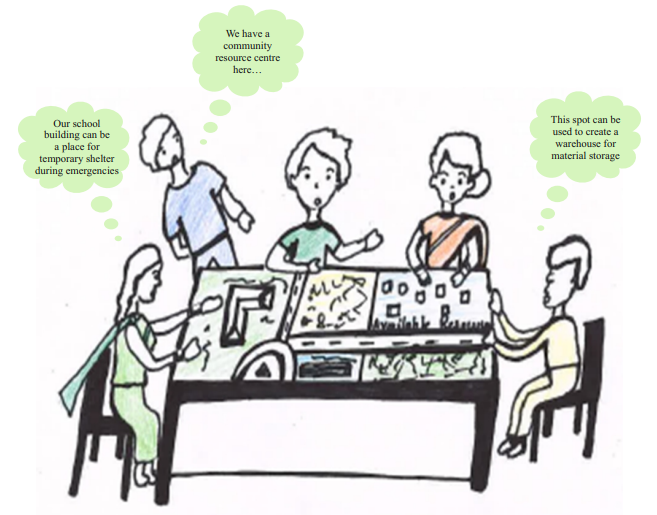Resource Mapping
Resource Mapping
Community Resource Mapping or asset mapping is a systematic process in which the community members are involved in developing an inventory of the resources that are available in the community. The goal is to identify resources and enhance skilful utilisation of available resources during crisis and to look in to ways to strengthen or add on community resources. Understanding the available resources and gathering information on optimal utilization of community resources helps in prompt response during emergencies. This would minimize vulnerability and maximise adaptation during the different phases of the disaster management cycle.


Pre-mapping
- Formation of task force who would facilitate the resource mapping process.
- Identifying key stakeholders who have complete awareness about the resources available in the community. Participants need to be from diverse sociodemographics, e.g., gender, class, religion, age, ethnicity, etc.
- Building the agenda for the activity and setting the goals.
- Developing tools, checklists or discussion points for the activity.
- Prepare the community in advance by providing prior information about the activity.
Mapping
- Orientation about the activity: The community members are informed about the significance, scope and relevance of resource mapping and how it would help in minimising the severity of the impact and foster resilience among community members.
- Transect walk: The resource mapping team goes in person or help community members recall from historical memory on the available community resources.
- Picturing the resource: The community members are helped to draw a map of the community using the available materials (chalk/limestone powder, different colours, etc.) and asked to mark the resources available in the community using symbols. Some examples of resources that can be mapped are: safer evacuation sites, services available, organisations and local institutions available, programs that are happening in the community, community gathering sites, health facilities, support groups available, mental health support facilities, etc.
- Discussion: How the resources can be utilised during emergencies i.e., optimising community's resource utilisation during emergencies. The discussion should also focus on: identifying new resources, ensuring that the resources are accessible to all community members, duplication of services, coordination and collaboration among stakeholders.
- Corrective Feedback: The facilitator provides insight on how the resources can be used, enhancing faster recovery of resources, understanding gaps in utilisation, steps to be taken to minimise gaps and efforts aiming at preserving and enriching community resources and follow-up systems that have to be installed for the community to monitor and enhance resource preservation, utilisation and upgradation.
- Designation: Designating responsible persons as community resource team for following up the resolutions taken during the resource mapping activity.
- Documentation: The process involved, stakeholders who participated, the resource map that evolved and discussion that followed post mapping activity and resolutions taken are documented in detail.
Action
- Arriving at a common agreement on the resolutions that were taken during the mapping activity.
- Creating plans and strategies to reach the goals.
- Periodic follow-up on the resolutions taken.
Post action
- Critical evaluation of the activities carried out by the community resource team.
- Revision of plans and continuation of resource preservation and enhancement.
Last Modified : 11/29/2023
This topic covers the information about Policies a...
Provides summary of District Disaster Management P...
This topic provides information about Internationa...
This topic provides information about Emergency He...
